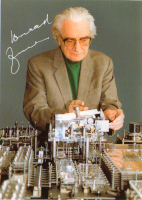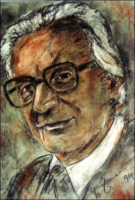Konrad Zuse (1910–1995) was the leading computer pioneer in Germany.
He studied Mechanical and Civil Engineering at the Technische Hochschule Berlin-Charlottenburg
(now Technische Universität Berlin (TUB)) from 1928 until 1935.
After a short stint at the Henschel Flugzeugwerke (Henschel Airplane Company) he began the invention
and construction of program-controlled computers in the living room (!) of his parents. In 1941 Zuse
founded his own company in Berlin and moved into larger rooms. During the years 1936 to 1945 he developed
and built about seven computers, most of which were destroyed during the air raids on Berlin.
Among those destroyed computers was the Z3, which Zuse had presented on 1941May12 to visitors
from the DVL (German Aeronautics Research Institute) as the first automatic program-controlled
computer. Only the Z4 and the L3, an experimental model of a logic computer, survived the war
and were brought in early 1945 to Hinterstein, a village in the Bavarian Alps.
All these computers used electromechanical elements. The CPU of the Z4 was based on relay technology and
the storage was purely mechanical, based on a mechanical bit, which Zuse had invented at the beginning
of his work on computers. The Z4 was later rented by the ETH Zurich and worked there from 1950 to 1955
and is today presented at the
Deutsches Museum in Munich.
In 1949 Zuse moved from Bavaria to Neukirchen in the northern part of Hesse, where he founded a new company,
the Zuse KG. This company grew steadily in the 1950ies and 1960ies, but due to the fierce competition
in the computer field it came into troubles in the second half of the 1960ies, and as
numerous other computer companies in Europe, disappeared from the scene.
Nevertheless, Konrad Zuse was one of the great pioneers of computing, a successful entrepreneur,
and, additionally, an artist, as his self portrait (above right) and numerous other paintings show.



